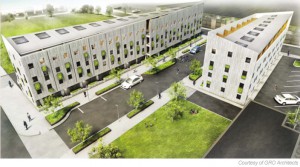New Jersey Future Blog
Forum Roundup: Creative Housing Solutions for Changing Demographics
March 26th, 2013 by Christine Barcia Moore
David Fisher PP, vice president of governmental affairs for K. Hovnanian Homes, opened the Creative Housing Solutions for Changing Demographics panel discussion at New Jersey Future’s 2013 Redevelopment Forum by focusing on the demographic trends that are driving market demand for housing. According to Fisher, the housing industry is looking at three future growth sectors: echo-Boomers (the children of the Baby Boomers, ranging in age from the mid-20s to early 30s); aging Baby Boomers; and foreign-born populations. He noted a decline in the U.S. birth rate and in the New Jersey school-age population as shaping the changing demand for housing away from single-family homes and toward multi-family units.
In the 1990s and early 2000s, Fisher said, multi-family building accounted for about 10% to 20% of new building; today that number is at 60%. In addition, in New Jersey, 65% of households have no children under the age of 18, which also shapes housing demand. “We’re not building much single-family housing in the state any more,” he said.
He also noted that fewer young people want cars, which means the need for convenience and “walkability” in neighborhoods has increased. “Walkability creates value,” stated Fisher.
Fisher closed with a look at the challenges created by these shifts, including matching housing value and price to market demand, overcoming redevelopment impediments, and meeting financing and lending requirements. “There’s real challenges to bringing product to market at a price that makes sense and so we’re constantly trying to evaluate that and reassess where we can best serve,” he said.
Robert Antonicello, executive director of the Jersey City Redevelopment Agency, spoke next. He explained that prior to 2006 the agency was price-driven, but since then has become mission-driven. Using Harriet Tubman Homes as an example, Antonicello described how the low- to moderate-income housing project represents the mission of affordable, sustainable, durable and income-inclusionary housing. He emphasized how the agency has gained experience in delivering a better project. “From that [project] we learned a lot about how to build durable, sustainable and energy-efficient housing,” he said.
Antonicello listed other recent housing projects, including Summit Heights, Mary Norton Manor, North Street and Jackson Green, from which lessons were learned. He emphasized that building communities, not just good design, is the goal of these projects. “I’m old enough to know when we used to call redevelopment ‘urban renewal,’ and I actually think that ‘urban renewal’ is a good term in the sense that it was about renewing a community,” he said.
Micro-unit housing, affordable units of approximately 300 square feet, are another innovative option that the agency has offered. Marketed toward students, these units are in buildings with collaborative workspace, living space and common-area kitchens in addition to those in individual units.
George Vallone, president of Hoboken Brownstone Co., who moderated the panel, added that the “collaboration of the planning departments with the redevelopment agencies, which have a much more financial focus, is what makes these projects.” That combination of financial input and planning input, taking into account demographics, is creating innovative housing, he said.
The final speaker, Grace Egan, the executive director of the New Jersey Foundation for Aging, highlighted the sharp increase in the population aged 60 and over in every county in New Jersey. This population’s needs were the subject of a 2009 study, updated in 2012, that examined economic policy through the lens of financial security for seniors. In New Jersey, for 25% of seniors, Social Security is the sole source of income and averages about $14,000 annually, an amount that does not cover living expenses. In addition, it is estimated that about 9% of this elderly population lives at or below the federal poverty level. Housing costs, according to the study, put a heavy burden on some elder households, representing as much as half of total expenses. “The only thing that really closes the gap of expenses is affordable housing,” said Egan.
Christine Barcia Moore is a freelance journalist.

















